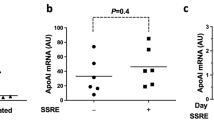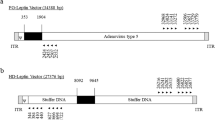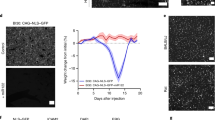Abstract
Although the use of nonviral vectors for gene therapy offers distinct advantages including the lack of significant inflammatory and immune responses, the levels of expression in vivo remain much lower than those obtained with their viral counterparts. One reason for such low expression is that unlike many viruses, plasmids have not evolved mechanisms to target to the nucleus of the nondividing cell. In the absence of mitosis, plasmids are imported into the nucleus in a sequence-specific manner, and we have shown in cultured cells by transfection and microinjection experiments that the SV40 enhancer mediates plasmid nuclear import in all cell types tested (Dean et al., 1999, Exp Cell Res 253: 713–722). To test the effect of this import sequence on gene transfer in the intact animal, we have recently developed an electroporation method for DNA delivery to the intact mesenteric vasculature of the rat. Plasmids expressing luciferase or GFP from the CMV immediate-early promoter/enhancer and either containing or lacking the SV40 enhancer downstream of the reporter gene were transferred to the vasculature by electroporation. When transfected into actively dividing populations of smooth muscle or epithelial cells, the plasmids gave similar levels of expression. By contrast, the presence of the SV40 sequence greatly enhanced gene expression of both reporters in the target tissue. At 2 days post-transfer, plasmids with the SV40 sequence gave 10-fold higher levels of luciferase expression, and at 3 days the difference was over 40-fold. The presence of the SV40 sequence did not simply increase the rate of nuclear import and expression, since expression from the SV40-lacking plasmid did not increase beyond that seen at day 2, the time of maximum expression for either plasmid. In situ hybridization experiments confirmed that the increased gene transfer and expression was indeed due to increased nuclear localization of the delivered SV40 sequence-containing plasmid. Based on these findings, the ability to target DNA to the nucleus can increase gene transfer in vivo and inclusion of the SV40 sequence into plasmids will enhance nonviral gene delivery.
This is a preview of subscription content, access via your institution
Access options
Subscribe to this journal
Receive 12 print issues and online access
$259.00 per year
only $21.58 per issue
Buy this article
- Purchase on Springer Link
- Instant access to full article PDF
Prices may be subject to local taxes which are calculated during checkout






Similar content being viewed by others
References
Parker SE et al. Cancer gene therapy using plasmid DNA: safety evaluation in rodents and non-human primates [see comments]. Hum Gene Ther 1995; 6: 575–590.
Zabner J et al. Cellular and molecular barriers to gene transfer by a cationic lipid. J Biol Chem 1995; 270: 18997–19007.
Dean DA, Dean BS, Muller S, Smith LC . Sequence requirements for plasmid nuclear entry. Exp Cell Res 1999; 253: 713–722.
Dean DA . Nucleocytoplasmic trafficking. In: Mahato RI (ed). Pharmaceutical Perspectives of Nucleic Acid-based Therapeutics. Harwood Academic Publishers: 2002, in press.
Fasbender A, Zabner J, Zeiher BG, Welsh MJ . A low rate of cell proliferation and reduced DNA uptake limit cationic lipid-mediated gene transfer to primary cultures of ciliated human airway epithelia. Gene Therapy 1997; 4: 1173–1180.
Brunner S et al. Cell cycle dependence of gene transfer by lipoplex, polyplex and recombinant adenovirus. Gene Therapy 2000; 7: 401–407.
Capecchi MR . High efficiency transformation by direct microinjection of DNA into cultured mammalian cells. Cell 1980; 22: 479–488.
Graessman M, Graessman A . Regulation of SV40 gene expression. Adv Cancer Res 1981; 35: 111–149.
Graessman M et al. Helper activity for gene expression, a novel function of the SV40 enhancer. Nucleic Acids Res 1989; 17: 6603–6612.
Kopchick JJ, Ju G, Skalka AM, Stacey DW . Biological activity of cloned retroviral DNA in microinjected cells. Proc Natl Acad Sci USA 1981; 78: 4383–4387.
Mirzayans R, Remy AA, Malcom PC . Differential expression and stability of foreign genes introduced into human fibroblasts by nuclear versus cytoplasmic microinjection. Mutat Res 1992; 281: 115–122.
Thornburn AM, Alberts AS . Efficient expression of miniprep plasmid DNA after needle micro-injection into somatic cells. Biotechniques 1993; 14: 356–358.
Dean DA . Import of plasmid DNA into the nucleus is sequence specific. Exp Cell Res 1997; 230: 293–302.
Wilson GL, Dean BS, Wang G, Dean DA . Nuclear import of plasmid DNA in digitonin-permeabilized cells requires both cytoplasmic factors and specific DNA sequences. J Biol Chem 1999; 274: 22025–22032.
Vacik J, Dean BS, Zimmer WE, Dean DA . Cell-specific nuclear import of plasmid DNA. Gene Therapy 1999; 6: 1006–1014.
Martin JB, Young JL, Benoit JN, Dean DA . Gene transfer to intact mesenteric arteries by electroporation. J Vasc Res 2000; 37: 372–380.
Lohr F, Wenz F, Haas S, Flentje M . Comparison of proliferating cell nuclear antigen (PCNA) staining and BrdUrd-labelling index under different proliferative conditions in vitro by flow cytometry. Cell Prolif 1995; 28: 93–104.
Li S et al. Muscle-specific enhancement of gene expression by incorporation of the SV40 enhancer in the expression plasmid. Gene Therapy 2001; 8: 494–497.
Dean DA, Kasamatsu H . Signal- and energy-dependent nuclear transport of SV40 Vp3 by isolated nuclei. Establishment of a filtration assay for nuclear protein import. J Biol Chem 1994; 269: 4910–4916.
Shelton ER, Wassarman PM, DePamphilis ML . Structure, spacing, and phasing of nucleosomes on isolated forms of mature simian virus 40 chromosomes. J Biol Chem 1980; 255: 771–782.
Friez M, Hermansen R, Milavetz B . Chromatin structure of the simian virus 40 late promoter: a deletional analysis. J Virol 1999; 73: 1990–1997.
Reddy JA, Dean D, Kennedy MD, Low PS . Optimization of folate-conjugated liposomal vectors for folate receptor-mediated gene therapy. J Pharm Sci 1999; 88: 1112–1118.
Langle-Rouault F et al. Up to 100-fold increase of apparent gene expression in the presence of Epstein–Barr virus oriP sequences and EBNA1: implications of the nuclear import of plasmids. J Virol 1998; 72: 6181–6185.
Mesika A, Grigoreva I, Zohar M, Reich Z . A regulated, NFkappaB-assisted import of plasmid DNA into mammalian cell nuclei. Mol Ther 2001; 3: 653–657.
Sherman MP, Greene WC . Slipping through the door: HIV entry into the nucleus. Microbes Infect 2002; 4: 67–73.
Zennou V et al. HIV-1 genome nuclear import is mediated by a central DNA flap. Cell 2000; 101: 173–185.
Matsumoto T et al. Successful and optimized in vivo gene transfer to rabbit carotid artery mediated by electronic pulse. Gene Therapy 2001; 8: 1174–1179.
Manthorpe M, Hartikka J, Vahlsing HL, Sawdey M . Quantification of plasmid DNA expression in vivo. In: Ferre F (ed). Gene Quantification. Burhaüser: Cambridge, MA, 1996.
Moorman AF, Houweling AC, de Boer PA, Christoffels VM . Sensitive nonradioactive detection of mRNA in tissue sections: novel application of the whole-mount in situ hybridization protocol. J Histochem Cytochem 2001; 49: 1–8.
Acknowledgements
This work was supported by Grants HL59956 from the NHLBI (DAD) and DK51430 from the NIDDK (JNB) and a predoctoral fellowship from the American Heart Association (JLY).
Author information
Authors and Affiliations
Rights and permissions
About this article
Cite this article
Young, J., Benoit, J. & Dean, D. Effect of a DNA nuclear targeting sequence on gene transfer and expression of plasmids in the intact vasculature. Gene Ther 10, 1465–1470 (2003). https://doi.org/10.1038/sj.gt.3302021
Received:
Revised:
Accepted:
Published:
Issue Date:
DOI: https://doi.org/10.1038/sj.gt.3302021
Keywords
This article is cited by
-
Nucleic acid delivery to mesenchymal stem cells: a review of nonviral methods and applications
Journal of Biological Engineering (2019)
-
A super gene expression system enhances the anti-glioma effects of adenovirus-mediated REIC/Dkk-3 gene therapy
Scientific Reports (2016)
-
A Double-Pulse Approach For Electrotransfection
The Journal of Membrane Biology (2014)
-
Proteomic and Functional Analyses of Protein–DNA Complexes During Gene Transfer
Molecular Therapy (2013)
-
Cell-Specific Targeting Strategies for Electroporation-Mediated Gene Delivery in Cells and Animals
The Journal of Membrane Biology (2013)



